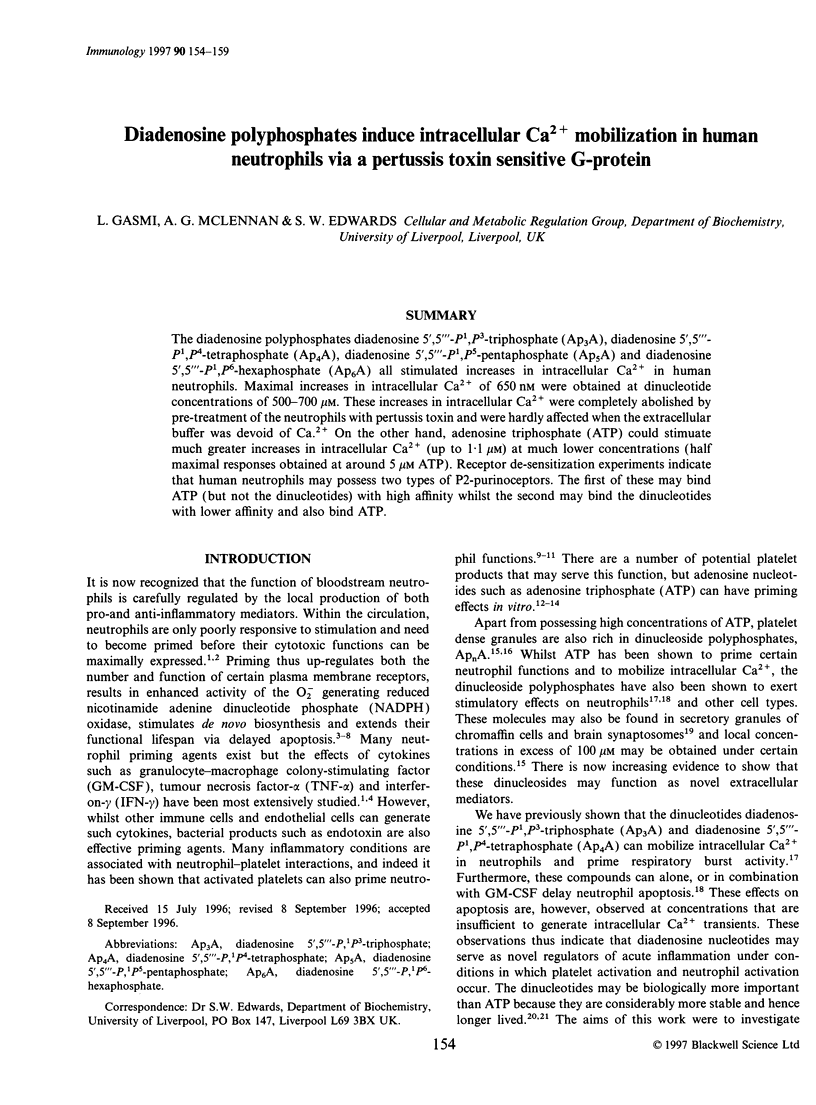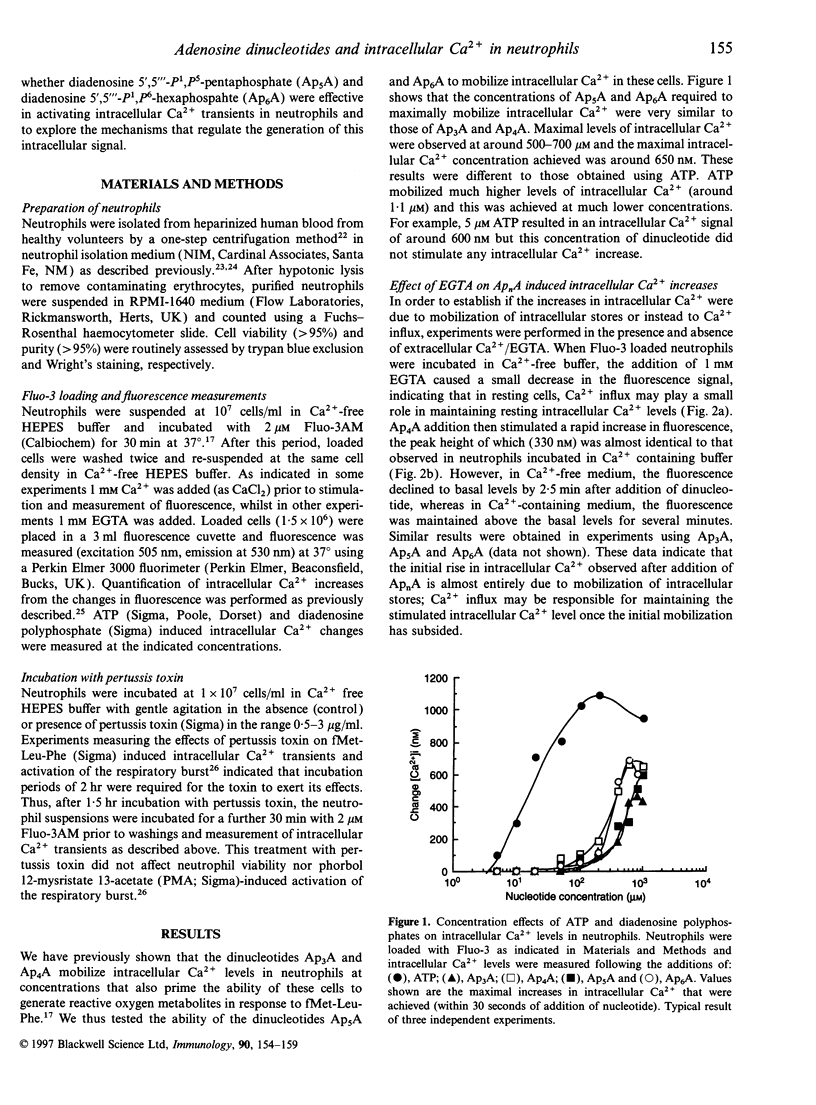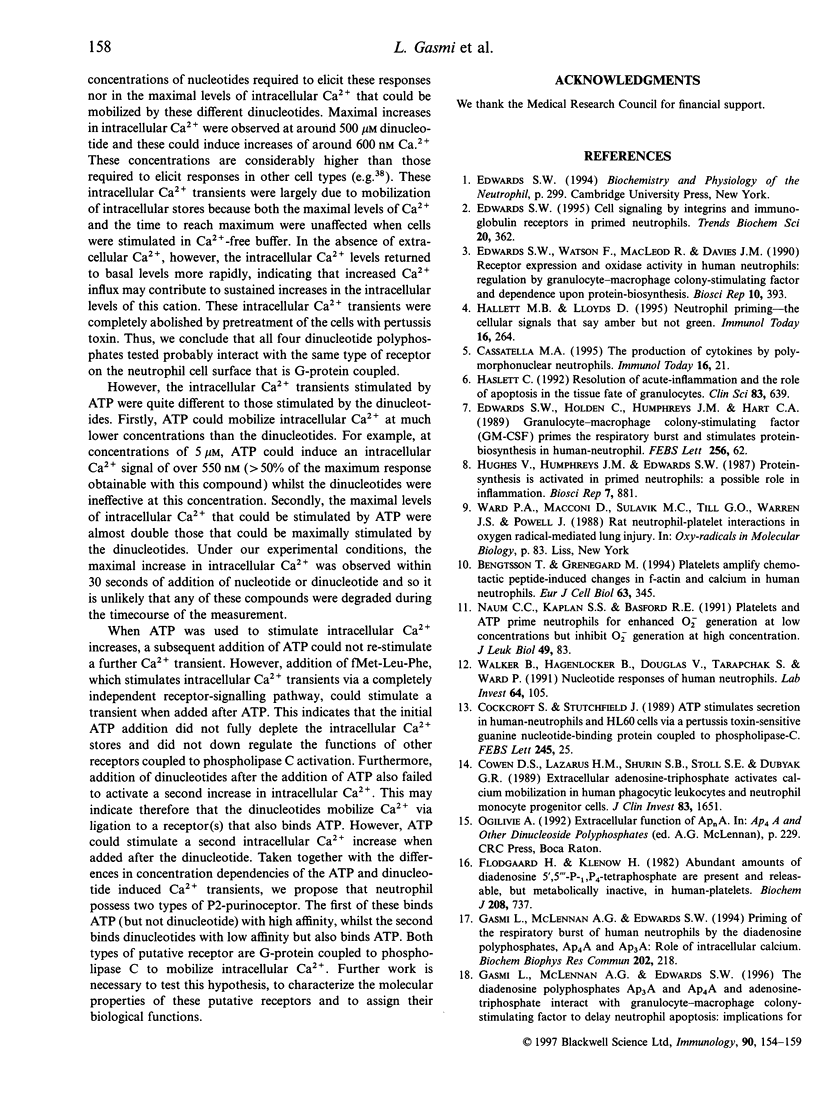Abstract
The diadenosine polyphosphates diadenosine 5',5"'-P1,P3-triphosphate (Ap3A), diadenosine 5',5"'-P1,P4-tetraphosphate (Ap4A), diadenosine 5',5"'-P1,P5-pentaphosphate (Ap5A) and diadenosine 5',5"'-P1,P6-hexaphosphate (Ap6A) all stimulated increases in intracellular Ca2+ in human neutrophils. Maximal increases in intracellular Ca2+ of 650 nM were obtained at dinucleotide concentrations of 500-700 microM. These increases in intracellular, Ca2+ were completely abolished by pre-treatment of the neutrophils with pertussis toxin and were hardly affected when the extracellular buffer was devoid of Ca2+. On the other hand, adenosine triphosphate (ATP) could stimulate much greater increases in intracellular Ca2+ (up to 1.1 microM) at much lower concentrations (half maximal responses obtained at around 5 microM ATP). Receptor de-sensitization experiments indicate that human neutrophils may possess two types of P2-purinoceptors. The first of these may bind ATP (but not the dinucleotides) with high affinity whilst the second may bind the dinucleotides with lower affinity and also bind ATP.
Full text
PDF





Selected References
These references are in PubMed. This may not be the complete list of references from this article.
- Abbracchio M. P., Burnstock G. Purinoceptors: are there families of P2X and P2Y purinoceptors? Pharmacol Ther. 1994;64(3):445–475. doi: 10.1016/0163-7258(94)00048-4. [DOI] [PubMed] [Google Scholar]
- Bengtsson T., Grenegård M. Platelets amplify chemotactic peptide-induced changes in F-actin and calcium in human neutrophils. Eur J Cell Biol. 1994 Apr;63(2):345–349. [PubMed] [Google Scholar]
- Cassatella M. A. The production of cytokines by polymorphonuclear neutrophils. Immunol Today. 1995 Jan;16(1):21–26. doi: 10.1016/0167-5699(95)80066-2. [DOI] [PubMed] [Google Scholar]
- Castro E., Torres M., Miras-Portugal M. T., Gonzalez M. P. Effect of diadenosine polyphosphates on catecholamine secretion from isolated chromaffin cells. Br J Pharmacol. 1990 Jun;100(2):360–364. doi: 10.1111/j.1476-5381.1990.tb15809.x. [DOI] [PMC free article] [PubMed] [Google Scholar]
- Chen Z. P., Levy A., Lightman S. L. Nucleotides as extracellular signalling molecules. J Neuroendocrinol. 1995 Feb;7(2):83–96. doi: 10.1111/j.1365-2826.1995.tb00671.x. [DOI] [PubMed] [Google Scholar]
- Cockcroft S., Stutchfield J. ATP stimulates secretion in human neutrophils and HL60 cells via a pertussis toxin-sensitive guanine nucleotide-binding protein coupled to phospholipase C. FEBS Lett. 1989 Mar 13;245(1-2):25–29. doi: 10.1016/0014-5793(89)80184-x. [DOI] [PubMed] [Google Scholar]
- Cowen D. S., Lazarus H. M., Shurin S. B., Stoll S. E., Dubyak G. R. Extracellular adenosine triphosphate activates calcium mobilization in human phagocytic leukocytes and neutrophil/monocyte progenitor cells. J Clin Invest. 1989 May;83(5):1651–1660. doi: 10.1172/JCI114064. [DOI] [PMC free article] [PubMed] [Google Scholar]
- Edwards S. W. Cell signalling by integrins and immunoglobulin receptors in primed neutrophils. Trends Biochem Sci. 1995 Sep;20(9):362–367. doi: 10.1016/s0968-0004(00)89077-5. [DOI] [PubMed] [Google Scholar]
- Edwards S. W., Holden C. S., Humphreys J. M., Hart C. A. Granulocyte-macrophage colony-stimulating factor (GM-CSF) primes the respiratory burst and stimulates protein biosynthesis in human neutrophils. FEBS Lett. 1989 Oct 9;256(1-2):62–66. doi: 10.1016/0014-5793(89)81718-1. [DOI] [PubMed] [Google Scholar]
- Edwards S. W., Watson F., MacLeod R., Davies J. Receptor expression and oxidase activity in human neutrophils: regulation by granulocyte-macrophage colony-stimulating factor and dependence upon protein biosynthesis. Biosci Rep. 1990 Aug;10(4):393–401. doi: 10.1007/BF01117239. [DOI] [PubMed] [Google Scholar]
- Edwards SW. The O-2 Generating NADPH Oxidase of Phagocytes: Structure and Methods of Detection. Methods. 1996 Jun;9(3):563–577. doi: 10.1006/meth.1996.0064. [DOI] [PubMed] [Google Scholar]
- Ferrante A., Thong Y. H. Optimal conditions for simultaneous purification of mononuclear and polymorphonuclear leucocytes from human blood by the Hypaque-Ficoll method. J Immunol Methods. 1980;36(2):109–117. doi: 10.1016/0022-1759(80)90036-8. [DOI] [PubMed] [Google Scholar]
- Flodgaard H., Klenow H. Abundant amounts of diadenosine 5',5"'-P1,P4-tetraphosphate are present and releasable, but metabolically inactive, in human platelets. Biochem J. 1982 Dec 15;208(3):737–742. doi: 10.1042/bj2080737. [DOI] [PMC free article] [PubMed] [Google Scholar]
- Gasmi L., McLennan A. G., Edwards S. W. Priming of the respiratory burst of human neutrophils by the diadenosine polyphosphates, AP4A and AP3A: role of intracellular calcium. Biochem Biophys Res Commun. 1994 Jul 15;202(1):218–224. doi: 10.1006/bbrc.1994.1915. [DOI] [PubMed] [Google Scholar]
- Green A. K., Cobbold P. H., Dixon C. J. Cytosolic free Ca2+ oscillations induced by diadenosine 5',5"'-P1,P3-triphosphate and diadenosine 5',5"'-P1,P4-tetraphosphate in single rat hepatocytes are indistinguishable from those induced by ADP and ATP respectively. Biochem J. 1995 Sep 1;310(Pt 2):629–635. doi: 10.1042/bj3100629. [DOI] [PMC free article] [PubMed] [Google Scholar]
- Green A. K., Dixon C. J., McLennan A. G., Cobbold P. H., Fisher M. J. Adenine dinucleotide-mediated cytosolic free Ca2+ oscillations in single hepatocytes. FEBS Lett. 1993 May 10;322(2):197–200. doi: 10.1016/0014-5793(93)81567-j. [DOI] [PubMed] [Google Scholar]
- Hallett M. B., Lloyds D. Neutrophil priming: the cellular signals that say 'amber' but not 'green'. Immunol Today. 1995 Jun;16(6):264–268. doi: 10.1016/0167-5699(95)80178-2. [DOI] [PubMed] [Google Scholar]
- Harrison M. J., Brossmer R. Inhibition of platelet aggregation and the platelet release reaction by alpha, omega diadenosine polyphosphates. FEBS Lett. 1975 Jun 1;54(1):57–60. doi: 10.1016/0014-5793(75)81067-2. [DOI] [PubMed] [Google Scholar]
- Haslett C. Resolution of acute inflammation and the role of apoptosis in the tissue fate of granulocytes. Clin Sci (Lond) 1992 Dec;83(6):639–648. doi: 10.1042/cs0830639. [DOI] [PubMed] [Google Scholar]
- Hughes V., Humphreys J. M., Edwards S. W. Protein synthesis is activated in primed neutrophils: a possible role in inflammation. Biosci Rep. 1987 Nov;7(11):881–890. doi: 10.1007/BF01119479. [DOI] [PubMed] [Google Scholar]
- Lüthje J., Baringer J., Ogilvie A. Effects of diadenosine triphosphate (Ap3A) and diadenosine tetraphosphate (Ap4A) on platelet aggregation in unfractionated human blood. Blut. 1985 Dec;51(6):405–413. doi: 10.1007/BF00320727. [DOI] [PubMed] [Google Scholar]
- Lüthje J., Ogilvie A. Catabolism of Ap4A and Ap3A in whole blood. The dinucleotides are long-lived signal molecules in the blood ending up as intracellular ATP in the erythrocytes. Eur J Biochem. 1988 Apr 5;173(1):241–245. doi: 10.1111/j.1432-1033.1988.tb13990.x. [DOI] [PubMed] [Google Scholar]
- Lüthje J., Ogilvie A. Diadenosine triphosphate (Ap3A) mediates human platelet aggregation by liberation of ADP. Biochem Biophys Res Commun. 1984 Feb 14;118(3):704–709. doi: 10.1016/0006-291x(84)91451-7. [DOI] [PubMed] [Google Scholar]
- Lüthje J., Ogilvie A. The presence of diadenosine 5',5'''-P1,P3-triphosphate (Ap3A) in human platelets. Biochem Biophys Res Commun. 1983 Aug 30;115(1):253–260. doi: 10.1016/0006-291x(83)90997-x. [DOI] [PubMed] [Google Scholar]
- Merritt J. E., McCarthy S. A., Davies M. P., Moores K. E. Use of fluo-3 to measure cytosolic Ca2+ in platelets and neutrophils. Loading cells with the dye, calibration of traces, measurements in the presence of plasma, and buffering of cytosolic Ca2+. Biochem J. 1990 Jul 15;269(2):513–519. doi: 10.1042/bj2690513. [DOI] [PMC free article] [PubMed] [Google Scholar]
- Naum C. C., Kaplan S. S., Basford R. E. Platelets and ATP prime neutrophils for enhanced O2- generation at low concentrations but inhibit O2- generation at high concentrations. J Leukoc Biol. 1991 Jan;49(1):83–89. doi: 10.1002/jlb.49.1.83. [DOI] [PubMed] [Google Scholar]
- Ogilvie A., Lüthje J., Pohl U., Busse R. Identification and partial characterization of an adenosine(5')tetraphospho(5')adenosine hydrolase on intact bovine aortic endothelial cells. Biochem J. 1989 Apr 1;259(1):97–103. doi: 10.1042/bj2590097. [DOI] [PMC free article] [PubMed] [Google Scholar]
- Pintor J., Díaz-Rey M. A., Miras-Portugal M. T. Ap4A and ADP-beta-S binding to P2 purinoceptors present on rat brain synaptic terminals. Br J Pharmacol. 1993 Apr;108(4):1094–1099. doi: 10.1111/j.1476-5381.1993.tb13510.x. [DOI] [PMC free article] [PubMed] [Google Scholar]
- Pintor J., Díaz-Rey M. A., Torres M., Miras-Portugal M. T. Presence of diadenosine polyphosphates--Ap4A and Ap5A--in rat brain synaptic terminals. Ca2+ dependent release evoked by 4-aminopyridine and veratridine. Neurosci Lett. 1992 Mar 2;136(2):141–144. doi: 10.1016/0304-3940(92)90034-5. [DOI] [PubMed] [Google Scholar]
- Pintor J., Miras-Portugal M. T. P2 purinergic receptors for diadenosine polyphosphates in the nervous system. Gen Pharmacol. 1995 Mar;26(2):229–235. doi: 10.1016/0306-3623(94)00182-m. [DOI] [PubMed] [Google Scholar]
- Pintor J., Rotllán P., Torres M., Miras-Portugal M. T. Characterization and quantification of diadenosine hexaphosphate in chromaffin cells: granular storage and secretagogue-induced release. Anal Biochem. 1992 Feb 1;200(2):296–300. doi: 10.1016/0003-2697(92)90469-n. [DOI] [PubMed] [Google Scholar]
- Pintor J., Torres M., Castro E., Miras-Portugal M. T. Characterization of diadenosine tetraphosphate (Ap4A) binding sites in cultured chromaffin cells: evidence for a P2y site. Br J Pharmacol. 1991 Aug;103(4):1980–1984. doi: 10.1111/j.1476-5381.1991.tb12363.x. [DOI] [PMC free article] [PubMed] [Google Scholar]
- Pohl U., Ogilvie A., Lamontagne D., Busse R. Potent effects of AP3A and AP4A on coronary resistance and autacoid release of intact rabbit hearts. Am J Physiol. 1991 May;260(5 Pt 2):H1692–H1697. doi: 10.1152/ajpheart.1991.260.5.H1692. [DOI] [PubMed] [Google Scholar]
- Schulze-Lohoff E., Zanner S., Ogilvie A., Sterzel R. B. Vasoactive diadenosine polyphosphates promote growth of cultured renal mesangial cells. Hypertension. 1995 Dec;26(6 Pt 1):899–904. doi: 10.1161/01.hyp.26.6.899. [DOI] [PubMed] [Google Scholar]
- Walker B. A., Hagenlocker B. E., Douglas V. K., Tarapchak S. J., Ward P. A. Nucleotide responses of human neutrophils. Lab Invest. 1991 Jan;64(1):105–112. [PubMed] [Google Scholar]
- Watson F., Robinson J., Edwards S. W. Protein kinase C-dependent and -independent activation of the NADPH oxidase of human neutrophils. J Biol Chem. 1991 Apr 25;266(12):7432–7439. [PubMed] [Google Scholar]


